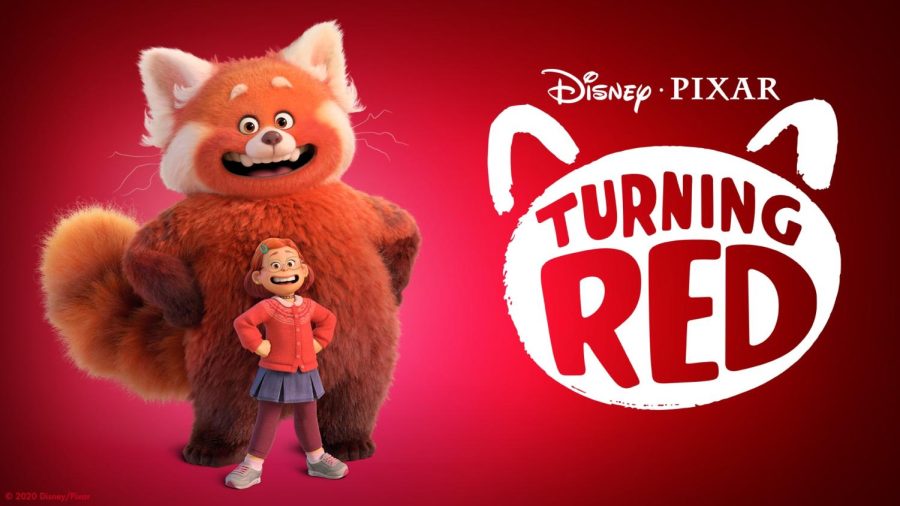Turning Red is a win for the female audience
New Pixar film explorers an important topic for young girls
“Turning Red” is a lighthearted film about a 13-year-old Asian-Canadian girl who is exploring who she really is and accepting it.
March 16, 2022
While bored on a Saturday evening, I was scrolling through Disney+ looking for something new to watch when I stumbled upon a new release: “Turning Red.” I started watching it and within the first few minutes, I fell in love with the film.
The film first started out diving into the life of a 13-year-old girl named Meilin Lee (Rosalie Chiang). She is a dorky, fun-loving girl who seems to have her life together now that she is in her teen years saying “I wear what I want, say what I want. 24/7, 365.” However, it is soon revealed that her life isn’t what it seems.
One morning Mei wakes up and realizes she has turned into a giant red panda. Concerned about her recent actions, her mother Ming (Sandra Oh) mistakes the event for something else. Mei hides from her mother not wanting her to see the “monster” she had become and described herself to be going through changes which included her becoming hairier and smelly. This then made her mother think it was a different type of change: the transition into adolescence.
This topic is not explored in many films, especially those made for children. It’s important to talk about and I find nothing wrong with making this the center of attention for the movie. While it can be uncomfortable to watch, especially if you are watching the film with your own parents, it’s natural and happens to us all which makes the film more relatable. While it is centered around a teen girl, that doesn’t mean the male audience can’t relate to the film’s content. They go through something very similar in the sense of being uncomfortable in their own bodies.
While many are confused about making Mei turn into a large red panda; however there is significance to it. In a short film on Disney+ about the making of the production, director Domee Shi stated that she was looking at the small, cuddly beast and pictured a teenager. She described the panda to be secluded, always eating things they are not supposed to and sleeping. She connected these aspects to many teenagers and knew it was the perfect animal to represent such a challenging time in our lives, which I agree with. Any other animal would have made very little sense, especially when you add the characteristics Shi saw in the red panda.
Mei has always had a strong relationship with her mother; however, this new challenge created a new division between the two. In her culture, Mei was taught to respect her parents, which meant doing every little task her mother asked of her. She never told her mother no, even at the expense of her own fun, such as going to karaoke with her three dorky best friends Miriam (Ava Morse), Abby (Hyein Park) and Priya (Maitreyi Ramakrishnan). However, that changes when the red panda inside of her awakens.
She is more disobedient, having little control over the fluctuation in her own voice, which results in her often yelling at Ming. Now, this is a problem every upcoming teen can relate to making the film more enjoyable. Parents can also relate as many have experienced this from them from time to time. Being able to make a compelling story that is relatable to both the adult and child audience, without the incorporation of sly adult comedy within, makes the movie even more of a success.
It is soon learned that the red panda was a blessing, turned curse, given to the Lee family by the gods a long time ago. Ming then becomes even more protective of her child as she had experienced the same thing when she was younger. This can be said of most, if not all, parents. As their children begin to grow up it is only natural to try to protect them from certain things, such as keeping them away from learning about puberty for as long as possible. I still feel like it is important to talk about; however, many reviews written by many parents who had watched the film seem to disagree.
Many of those who did not enjoy the movie stated that the topic of adolescence being shown to young children was not, in their eyes, kid-friendly. I can see where these parents are coming from. It can be awkward and uncomfortable to have these conversations for both a child and adult, but they still need to be exposed to the topic. It is in no way hidden, but many young viewers are less likely to pick up on the subject than their parents. They are more likely to just think they are watching a movie about a 13-year-old girl who is trying to be her true self. However, those children are also getting valuable lessons and useful information that they can look back to when they experience the same thing.
The production also was a large win for women in the Disney film industry as it is one of the only films to have an all-female leadership team. Each major role including director, producer and designer was filled by a woman. “Turning Red” also allowed for the first woman in 20 years to be the lead in digital effects for a Pixar film. It makes sense because the point of view is from a girl’s perspective; however, in the past, most of those roles were written by men, or men were put in charge of the film overall. This film is a gateway to more leadership roles in productions for Pixar in the future, which in my opinion, is a win for all women in the film industry.
We will see the growing popularity of “Turning Red” as more and more viewers decide to play it on their screens at home. It is a cute, lighthearted film that teaches valuable lessons to both the child and adult audience making it enjoyable for all, and I highly recommend sitting down and taking only an hour and a half of time out of your day to watch it.
5/5







